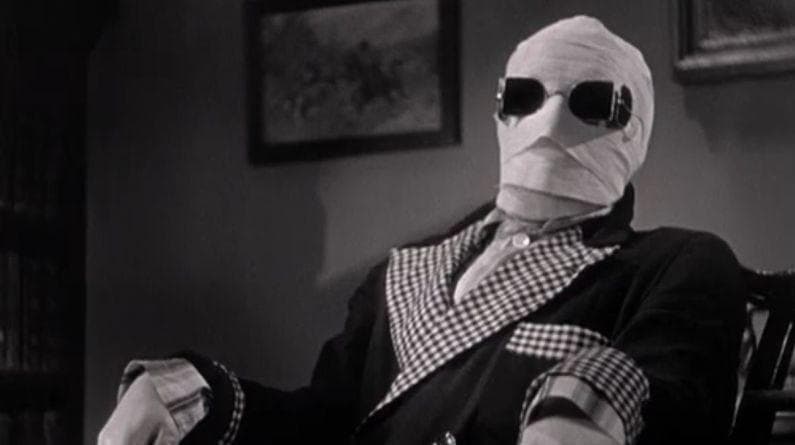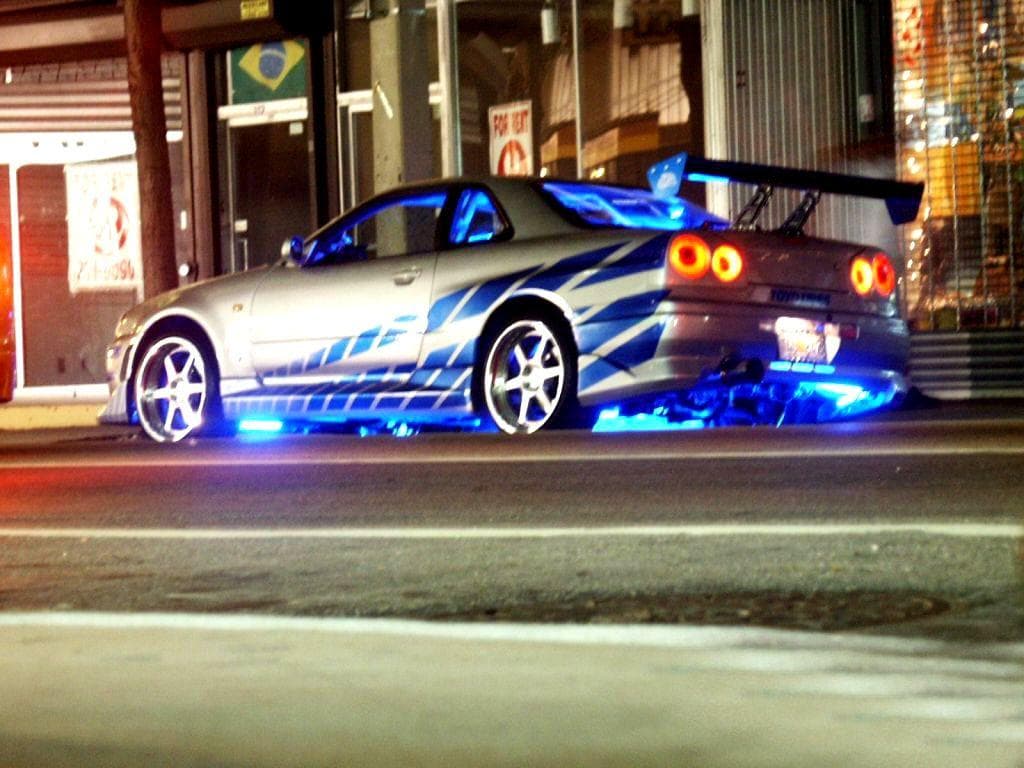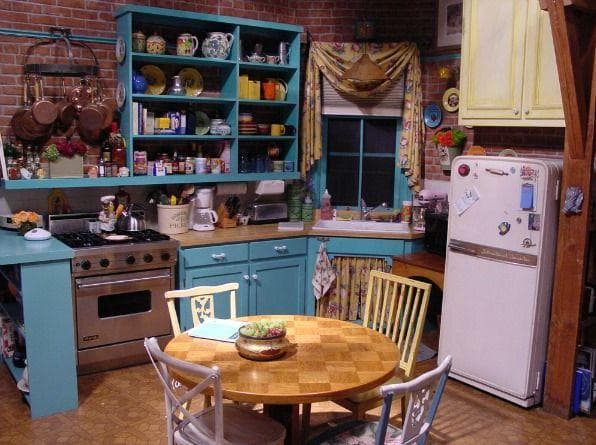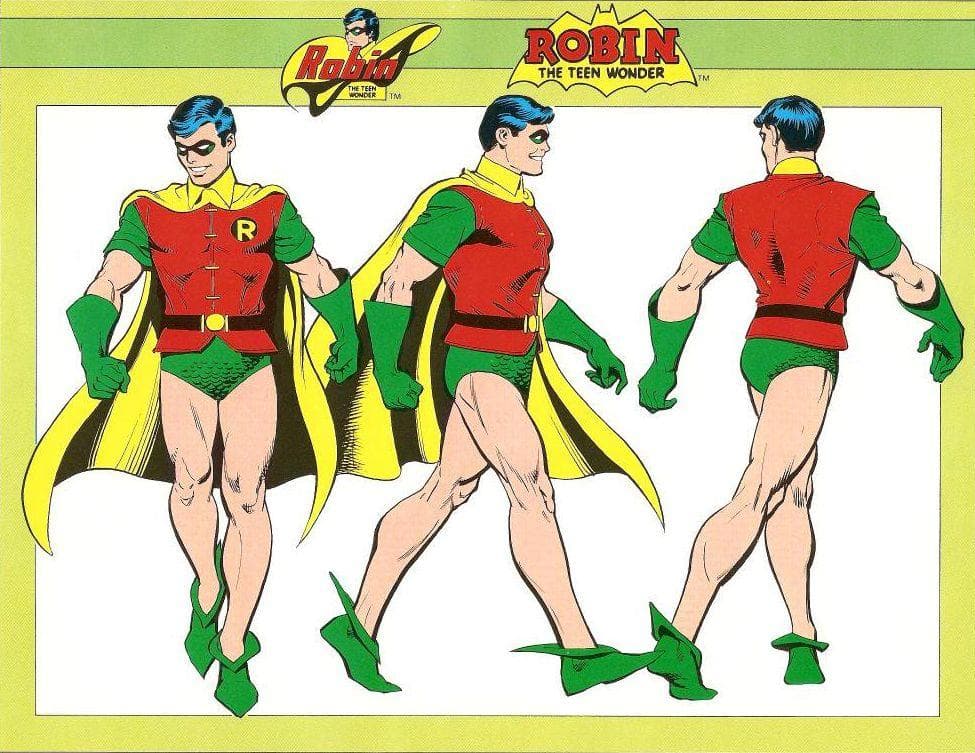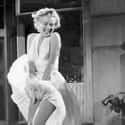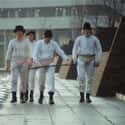(#12) The Seven Year Itch
- Marilyn Monroe, Carolyn Jones, Evelyn Keyes, Marguerite Chapman, Victor Moore, Oskar Homolka, Tom Ewell, Robert Strauss, Sonny Tufts
Few images in cinema history are as indelible as the one from Billy Wilder's The Seven Year Itch, in which Marilyn Monroe walks over a sidewalk grate and a gust of air blows up her flowing white dress. In this particular instance, the symbolism comes not from the garment itself, but rather from the combination of the dress and the actress wearing it.
White, as most people know, is a color of purity, innocence, and cleanliness. Monroe, on the other hand, is an all-time sex symbol who inspired a lot of impure, lustful, and just plain dirty thoughts among viewers. That idea is vital to the story, which finds a happily married man tempted by his comely neighbor. Putting a voluptuous vixen like Monroe in a color that screams purity plays on the psychological "Madonna-whore dichotomy" in which men view women as either chaste and pure or lusty and seductive. In this instance, she's seen in his eyes as both, simultaneously, which is where the comedy comes in. She's an example of unattainable perfection.
Costume designer William Travilla knew that was a fun concept to play with. He described the white dress as "cool and clean, in a dirty, dirty city."
(#10) Batman
- Jack Nicholson, Kim Basinger, Michael Keaton, Jack Palance, Billy Dee Williams, Jerry Hall, Michael Gough, Pat Hingle, Tracey Walter, Robert Wuhl, William Hootkins, Garrick Hagon, Denis Lill, Christopher Fairbank, Rachel Ryan, Sam Douglas, Paul Michael, Michael Balfour, Richard Durden, Steve Plytas, Rocky Taylor, Paul Birchard, Mac McDonald, John Sterland, Lee Wallace, Richard Strange, Philip Tan, Edwin Craig, John Dair, Terence Plummer, Del Baker, Leon Herbert, George Roth, Carl Chase, George Lane Cooper, Priscilla Cory, David Baxt, Pat Gorman, Wayne Michaels, Philip O'Brien, Katie Harper, Christian Wolf-La'Moy, Lachele Carl, Joel Cutrara, Keith Edwards, Liza Ross, Hugo Blick, Clyde Gatell, Valentino Musetti, Vincent Wong, Kit Hollerbach, Bruce McGuire, Clive Curtis, Pam Rose, Sharon Holm, Elliott Stein, Charles Roskilly, Adrian Meyers, Jon Soresi, Anthony Wellington, Amir M. Korangy, Jazzer Jeyes
In most cinematic iterations of Batman, the Joker is shown prominently wearing a purple suit. It's a perfect color for a supervillain. For starters, purple is rarely found in nature, which automatically gives it a mysterious, bordering on supernatural, aura. It's also the most powerful wavelength of electromagnetic energy, so we tend to associate it with magic or energy. Since purple is a secondary color, it nicely opposes the primary colors typically worn by superheroes.
Jack Nicholson wore a purple suit in Tim Burton's Batman, as did Heath Ledger in The Dark Knight. In each case, the costume is designed to unsettle by playing upon those qualities. The Joker is shown as an unusually disturbed figure with an unpredictable, dangerous energy and a mean streak that stands in direct opposition to the more noble deeds of Bruce Wayne's alter ego.
(#13) A Clockwork Orange
- Malcolm McDowell, Warren Clarke, Steven Berkoff, David Prowse, Adrienne Corri, Aubrey Morris, George Coulouris, Patrick Magee, Pat Roach, Michael Bates, Gaye Brown, John Clive, Margaret Tyzack, Philip Stone, Carol Drinkwater, Miriam Karlin, Anthony Sharp, John Savident, Godfrey Quigley, Peter Burton, Clive Francis, Gillian Hills, Sheila Raynor, Madge Ryan, James Marcus, Virginia Wetherell, Michael Gover, Carl Duering, John J. Carney, Vivienne Chandler, Katya Wyeth, Neil Wilson, Billy Russell, Michael Tarn, Paul Farrell, Robert Bruce, Norman Gay, Katharina Kubrick, Andros Epaminondas, Prudence Drage, Fred Hugh, Helen Ford, Maurice Bush, Alec Wallis, Shirley Jaffe, Barrie Cookson, Olive Mercer, Frankie Abbott, Leslie Nye, Tom Sye, Margaret Heald, Nat Pearn, Sister Watkins, Jeremy Curry, Steadman Clark, Winifred Sabine, Rex Rashley, Craig Hunter, Dr. Gundry, Barbara Scott, Jan Adair, Lee Fox, Richard Connaught, Cheryl Grunwald, Shane Shelton, Lindsay Campbell, Henry Robert, Arthur Tatler, Peter Hannon, Roy Beck, Pauline Taylor, Nicholas Hill, Fred Real, George O'Gorman, David Dawkins
You wouldn't think white would be the right color to wear if you're planning to partake in "a bit of the old ultraviolence," but that's exactly what Alex DeLarge and company wear in Stanley Kubrick's 1971 adaptation of A Clockwork Orange. It isn't hard to see what he was getting at. White is a clean, pristine color, and the characters are engaged in behavior that's bloody and messy. Irony!
Beyond that, the use of white is meant to mock high society. The color has long been associated with wealth and privilege, with members of the elite famously believing you shouldn't wear white after Labor Day. Alex's white shirt, pants, codpiece, and suspenders are accentuated with a bowler hat and a cane - two more fashion pieces associated with being old-school rich. Combined, they allow Alex to make fun of a class to which he does not belong. He imitates their fashion sense, then behaves in a manner completely inconsistent with their lifestyle.
Writing for the BFI, Elena Lazic was spot-on in saying that "seeing the violent images of Alex's gang framed by and absorbed into a soft aesthetic is unsettling in itself."
(#14) Saturday Night Fever
- John Travolta, Fran Drescher, Denny Dillon, Donna Pescow, Robert Costanzo, Karen Lynn Gorney, Julie Bovasso, Barry Miller, Paul Pape, Martin Shakar, Val Bisoglio, Joseph Cali, Bruce Ornstein
The white suit John Travolta wears in Saturday Night Fever is arguably the most famous in all of cinema. His character, Tony Manero, has an unhappy life. He works a tedious job at a hardware store. His parents have no hesitation about letting him know he's a disappointment compared to his brother. His friends are a bunch of racist and misogynist louts. When he puts on that suit and heads to the disco, though, his world becomes a lot more optimistic. He's a king when showing off his dance moves.
Saturday Night Fever costume designer Patrizia Von Bandenstein selected white - a color known for representing purity - for that purpose: "I reasoned that Tony's position in his traditional Italian-American family (overshadowed by his brother the seminarian, and undervalued for his compassion and dancing abilities) is in extreme contrast to his dominant position in the neighborhood." The white therefore reflects the bright, shining freedom he gets from the dark elements in his life when he's dancing.
Years later, another noted costume designer, Deborah Nadoolman, summed it up nicely for The Guardian, saying, "Saturday Night Fever was actually a very dark little movie, and this suit, made of completely gross polyester, was the shining light, the symbol of aspiration and hope that shone in the film."
(#8) Atonement
- Keira Knightley, Benedict Cumberbatch, Saoirse Ronan, James McAvoy, Vanessa Redgrave, Juno Temple, Brenda Blethyn, Romola Garai, Michelle Duncan, Alfie Allen, Tobias Menzies, Anthony Minghella, John Normington, Nonso Anozie, Gina McKee, Daniel Mays, Peter Wight, Harriet Walter, Neil Maskell, Patrick Kennedy, Wendy Nottingham, Johnny Harris, Bronson Webb, Michel Vuillermoz, Jérémie Renier, James Fiddy, Tilly Vosburgh, Tom Barker, Ian Bonar, Lionel Abelanski, Jamie Beamish, Elliot Francis, Leander Deeny, Tom Rooke, Roger Evans, Kelly Scott, Ryan Kiggell, Peter O'Connor, Billy Seymour, Ailidh Mackay, Felix von Simson, Bonnie Witney, Charlie von Simson, Angel Witney, Julia West, Jade Moulla, Olivia Grant, Georgia Oakley, Alice Orr-Ewing, Paul Stocker, Oliver Gilbert, Vivienne Gibbs, Craig Leonard, Paul Harper, Ben Harcourt, Katy Lawrence, Mark Holgate, Jack Harcourt, Matthew Forest, Sarah Shaul, Madeline Crowe, Jay Quinn, Richard Stacey, Catherine Philps, Nick Bagnall, Scarlett Dalton, Ben Webb, Alex Noodle, Charlie Banks, Emily Thomson, Bryony Reiss, Anna Singleton
If you've seen Atonement, odds are you remember the sight of Keira Knightley in a striking green backless dress. Her character Cecilia wears it in and around the film's signature romantic moment.
Part of what makes this dress so memorable is that, as The Guardian points out, it evokes "both sexual power and the potential for harm." Green is often associated with luck (i.e., a four-leaf clover), although in some cultures it's actually considered to be unlucky. Given that dichotomy, the use of this bold shade in the scene is ideal. So many contrasting moments of power and discomfort are happening simultaneously. An embarrassed Robbie (James McAvoy) has accidentally sent a dirty letter to Cecilia, but she's turned on by it and unexpectedly wants to make love to him. As they do so in the library, her younger sister Briony (Saoirse Ronan) walks in and mistakes their passion for an assault. Through it all, that stunning green dress is essentially providing commentary on the madness of the situation.
Atonement costume designer Jacqueline Durran credits director Joe Wright with the color selection, even if getting to it was tricky. She told Entertainment Weekly, "The specific shade he may not know until he sees it, so I will then offer him up as many shades as I can and he'll say 'That's the one!'"
(#4) Mean Girls
- Lindsay Lohan, Rachel McAdams, Amanda Seyfried, Tina Fey, Amy Poehler, Lacey Chabert, Lizzy Caplan, Tim Meadows, Ana Gasteyer, Daniel DeSanto, Neil Flynn, Jonathan Bennett, Diego Klattenhoff, Daniel Franzese, Jonathan Malen, Eve Crawford, Jack Newman, Bruce Hunter, Laura DeCarteret, Clare Preuss, Dan Willmott, Talia Russo, Marc Allen, Alisha Morrison, David Reale, Dwayne Hill, Darryl Armstrong, Kaylen Christensen, Sima Fisher, Rajiv Surendra, Krysta Carter, Ely Henry, Chris Ploszczansky, Julia Chantrey, Tara Shelley, Jan Caruana, Elana Shilling, Wai Choy, Michelyn Emelle, Jill Morrison, Bathsheba Garnett, Les Porter, Olympia Lukis, Noelle Boggio, Kristen Bone, Stefanie Drummond, Megan Millington, Nicole Crimi, Shannon Todd, Andreja Punkris, Jo Chim, Randi Lee Butcher, David Sazant, Erin Jarvis, Tyson Fennell, Sharron Matthews, Valerie Casault, Molly Shanahan, Miranda Edwards, Erin Thompson, Danielle Nguyen, Jessie Wright, Jacky Chamberlain, Jeff Moser, Ky Pham, Stephan Dickson, Michelle Hoffman, David Aherne, Graham Kartna, Nicholas A. Catalano, Alexandra Stapley, Ayo Agbonkpolo, Jordan Dawe, John Gadsden, Lucila Grzetic
Pink is generally equated with femininity. In fact, the color has long been used for baby girls in clothing, bedding, and, more recently, gender reveals. Red tends to represent strength or aggression. When white is added, it softens those qualities, creating something more representative of romance, charm, or tenderness.
The ensembles worn by Lindsay Lohan and her co-stars in the comedy Mean Girls use pink ironically. These characters are not sweet and demure. They're, well, mean, even going so far as to pen nasty comments about classmates in a "burn book." The use - or, one could argue, abuse - of pink in this way weaponizes femininity. Cady and pals might look pretty on the outside, but they're often ugly on the inside. Their outward appearance belies a sense of malice underneath.
The film's costume designer, Mary Jane Fort, compared the mean girls in their pink ensembles to over-indulging at a candy store, saying, "When you see this group, you want to feel like you walked into something delicious and wonderful even though it's kind of bad for you."
New Random Displays Display All By Ranking
About This Tool
Each individual movie scene plays a vital role. Whether it is based on a certain aesthetic choice or the coloring of the scene, colors subconsciously affect the mood of the audience. Color can represent many different things or feelings. Finding an attractive and unique way to use color to arouse the emotions of the audience is the real challenge. Let's take a look at some of the different colors used in movies and feel the emotions that color brings.
The random tool generates 16 items, you can check the list of movies. Many film producers like to use red, because it can easily arouse the original emotions. Lets' figure out that your favorite movie costumes really mean.
Our data comes from Ranker, If you want to participate in the ranking of items displayed on this page, please click here.

